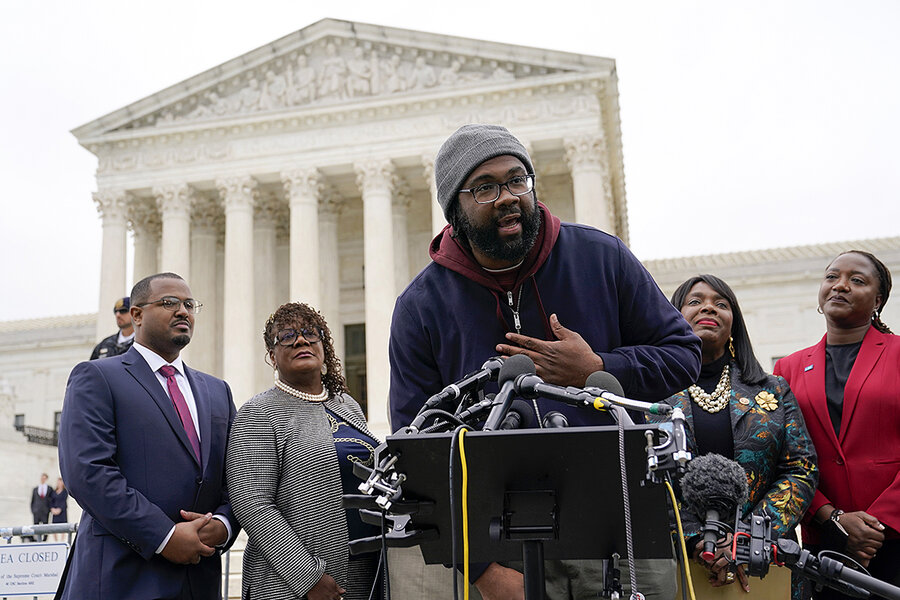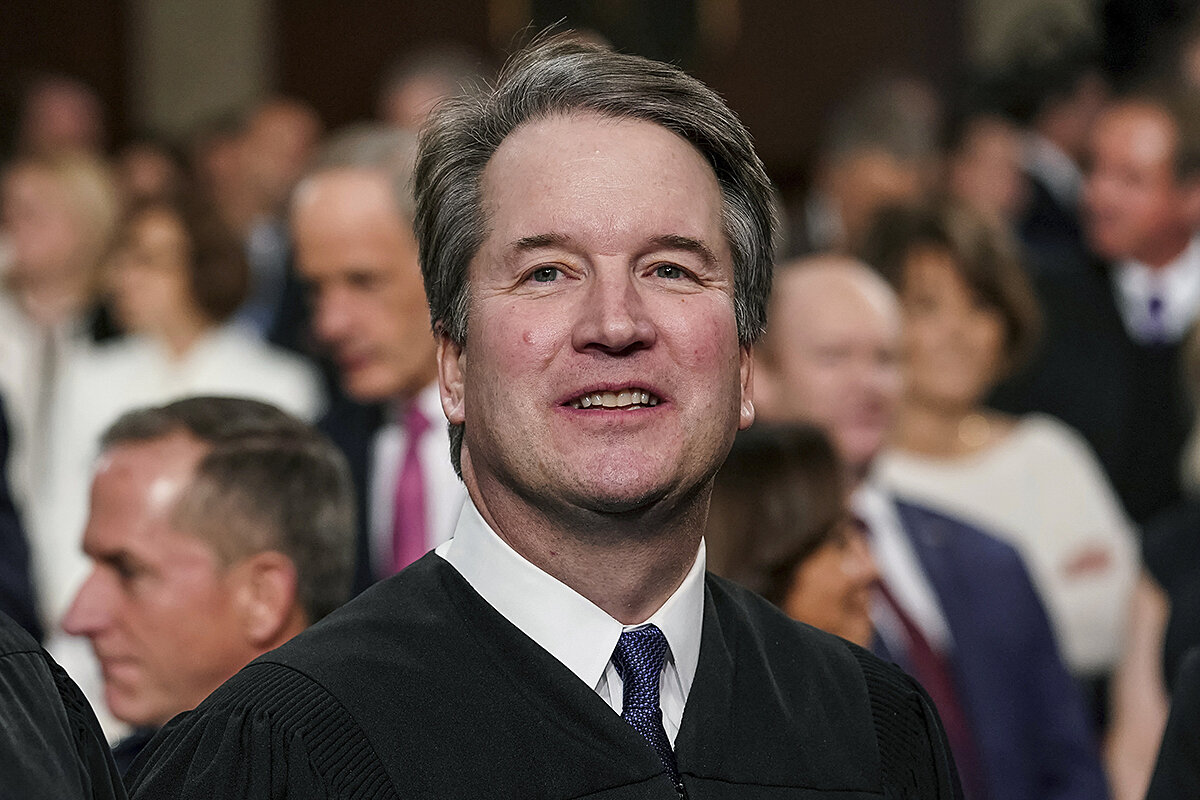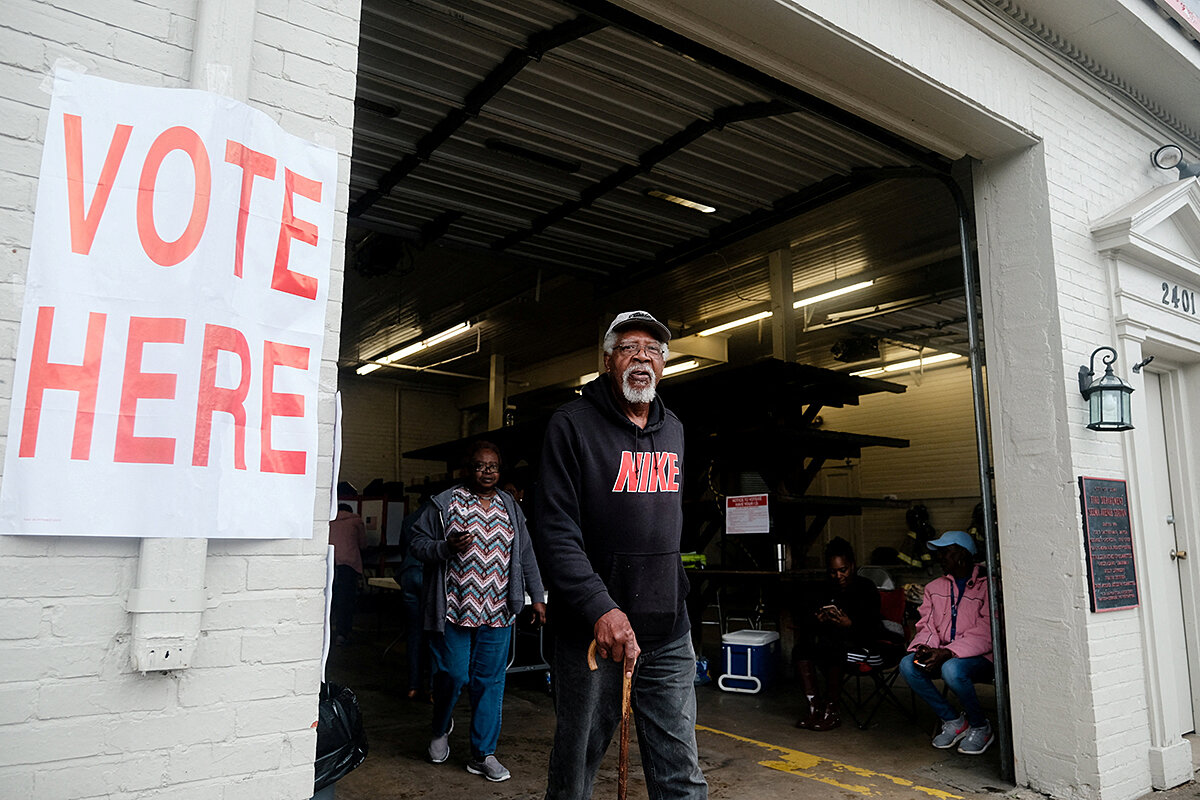In major win for voting rights, Supreme Court sides with Black Alabamians
Loading...
In a fractured, and surprising, ruling Thursday morning, the U.S. Supreme Court blocked a potentially discriminatory Alabama voting map. In doing so, the justices preserved a key section of the Voting Rights Act.
One of several cases this term examining – and potentially recasting – the function of race in American law and society, the case, Allen v. Milligan, had been closely watched. Specifically, the case concerned a challenge to a 2021 Alabama law called HB1, in which the state adopted a new congressional district map with only one majority-Black district, even though Black voters constitute 27% of the state’s population. It presented a head-on challenge to Section 2 of the Voting Rights Act.
The landmark civil rights law banned discriminatory voting practices adopted by many Southern states in the Jim Crow era. Section 2 says that states may not “deny or abridge the right of any citizen of the United States to vote on account of race or color.” Under the leadership of Chief Justice John Roberts, the high court has been kind to laws restricting voting access, notably in 2013 when he wrote the majority opinion in Shelby County v. Holder, striking down a different section of the landmark civil rights act.
Why We Wrote This
In one of the biggest rulings of this term so far, the U.S. Supreme Court upheld a key section of the Voting Rights Act. The case has important implications for both 2024 elections and democracy overall.
But in today’s Milligan decision, Chief Justice Roberts – joined by the court’s three-justice liberal wing and Justice Brett Kavanaugh – upheld a district court ruling that the Alabama law likely violates Section 2.
“The heart of these cases is not about the law as it exists. It is about Alabama’s attempt to remake our Section 2 jurisprudence anew,” wrote Chief Justice Roberts.
The ruling “does not diminish or disregard the concern that Section 2 may impermissibly elevate race” in state redistricting processes, he added. “Instead, the Court simply holds that a faithful application of precedent and a fair reading of the record do not bear those concerns out here.”
Alabama’s electoral map
“I am disappointed in today’s Supreme Court opinion but it remains the commitment of the Secretary of State’s Office to comply with all applicable election laws,” Alabama Secretary of State Wes Allen said in a statement after the ruling.
The case begins with the 2020 Census, which found that Alabama’s population had grown about 5% and was now one-quarter Black. In redrawing the state’s congressional map, lawmakers settled on a plan largely resembling the previous decade’s map: seven districts, with only one being majority-Black.
The state adopted that map by passing HB1, but local civil rights groups challenged the law, arguing that it violated Section 2 because the state could, and should, have created a second majority-Black district. In January 2022, a three-judge federal district court panel agreed that the map likely violated the Voting Rights Act and ordered Alabama to draw a new map. The state then filed an emergency appeal to the Supreme Court. The justices stayed the district court ruling while scheduling the appeal for a hearing on the merits last October, allowing the new map to be used in the 2022 midterm elections.
Arguments in the case focused on disagreements over when exactly voting rights are sufficiently harmed to constitute a Voting Rights Act violation. But notably, Alabama not only argued that its law didn’t violate Section 2 but also claimed that Section 2 challenges should now be evaluated per a “race-neutral benchmark” that uses modern computer technology to draw maps that don’t consider race at all. Because the state did this, Alabama argued, its map couldn’t possibly be abridging Alabamians’ voting rights on account of race.
In a dissent, Justice Clarence Thomas agreed with Alabama’s argument, writing that Section 2 “does not guarantee [racially] proportional representation.” In fact, the Constitution prohibits considering race in this way, he added: “to avoid setting Section 2 on a collision course with the Constitution, courts must apply a race-neutral benchmark in assessing any [racial gerrymandering] claim.”
In his majority opinion, Chief Justice Roberts responded that “forcing [racially] proportional representation” is already unlawful under the court’s Section 2 precedents. “The contention that mapmakers must be entirely ‘blind’ to race has no footing in our Section 2 case law,” he added.
Justice Kavanaugh, in a separate concurrence, supported the chief justice’s interpretations of the court’s Section 2 jurisprudence – though he didn’t join a section of the majority opinion undressing Alabama’s proposed race-neutral benchmark practice.
“The Court’s precedents [do] not mandate a proportional number of majority-minority districts,” he wrote. But, he added, “the authority to conduct race-based redistricting cannot extend indefinitely into the future.”
With the court’s three other conservative justices joining parts of Justice Thomas’ dissent and Justice Samuel Alito also writing a separate dissent, the Milligan decision makes clear that Chief Justice Roberts and Justice Kavanaugh are the ideological center of the current Supreme Court, says Mark Graber, a professor of law and politics at the University of Maryland.
“At least three of the other four [conservative] justices ... would want to bring wholesale changes to American constitutional law,” he adds. Justices Roberts and Kavanaugh “want to go slower.”
“It wouldn’t surprise me if we’re going to see affirmative action overruled later this term,” he continues. So upholding the Voting Rights Act ruling today could be seen as “Roberts not wanting to do too much, and this way both he and Kavanaugh can present themselves as moderates, and that’s very important to both of them.”
“Absolutely stunning development”
The immediate reaction to the court’s ruling was, for voting rights experts, surprise and delight.
“This is an absolutely stunning development,” wrote Nicholas Stephanopoulos, of Harvard Law School, on the Election Law Blog. “I would never have expected this Court to rule fully in favor of the plaintiffs in a Section 2 racial vote dilution case.”
In the shorter term, the Milligan decision could have a significant effect on the 2024 elections. Lawsuits challenging maps in states like Louisiana and Georgia have been stayed while the Supreme Court considered the Alabama case. Now voting rights groups like the American Civil Liberties Union, which has six redistricting cases active in federal courts, will push to resolve those cases before voters go to the polls.
“This was a huge moment,” says Sophia Lin Lakin, co-director of the ACLU’s Voting Rights Project.
“You’re probably going to see litigants moving forward, and moving pretty rapidly,” she adds. “With the lifting of stays that were put in place, we’ll be moving forward pretty quickly to try to get in place fair maps that don’t dilute the voting power of minority communities.”
Other voting rights observers believe the ramifications of Milligan could play out well beyond 2024.
“At its core this is a issue of, do racial and ethnic minorities in the South get to elect federal representatives that, you know, serve their communities, that are elected from their communities,” says David de la Fuente, a senior political analyst at the nonpartisan Third Way in Washington. He sees potential implications for redistricting maps in Arkansas and South Carolina, as well as states like Georgia and Louisiana with cases already pending.
“We don’t know how fast the states are going to be forced to act on this,” he says, adding that he could see an argument for drawing up to four additional Latino-majority districts in Texas. “I do think Alabama and Louisiana will have to redraw pretty fast. But some of the bigger, I guess, prizes like Georgia, Florida, Texas – this might be playing out for the next decade.”
Future of voting rights law
While the opinion is unquestionably a win for voting rights advocates, most court watchers don’t view it as a sea change in voting rights law. In their view, it’s a court preserving the status quo of a legal landscape where the Voting Rights Act has become increasingly difficult to enforce.
It would be imprudent to assume that this represents a “major turnaround in the court’s general skepticism about voting rights claims,” says Russell Wheeler, a senior fellow at the Brookings Institution in Washington. “By itself, this does not indicate a fundamental redirection on the part of at least the two ... somewhat conservative Justices Kavanaugh and Roberts.”
A 1993 precedent that states can’t draw new districts based solely on race, unless they have a compelling reason, for example, is still in place. It just happened to be clear enough, in Alabama’s case, that race could be given more consideration without it becoming the predominant consideration. And the majority opinion notes that it’s a rare win. Since 2010, wrote Chief Justice Roberts, “fewer than ten Section 2 suits” have been successful in federal courts.
“That’s an implicit recognition that the court’s existing precedents already made Section 2 hard to use,” said Michael Li, a redistricting expert at the Brennan Center for Justice, on Twitter.
“While Section 2 does really important, vital work in places like [central] Alabama, there are many places where its effects are much more limited despite the fact that those places also often have significant racial discrimination,” he added.
More challenges to the Voting Rights Act, and Section 2 specifically, are likely, experts say. And depending on the facts and arguments in those cases, the voting rights landscape could look very different in a few years.
Milligan shows that “at least two members of the conservative majority on the Supreme Court are open and receptive to some claims of racial gerrymandering,” says Mr. Wheeler.
“The African American plaintiffs should be happy about it,” he adds, “but I wouldn’t say that by itself this is a cause for viewing that, you know, the struggle is over.”







